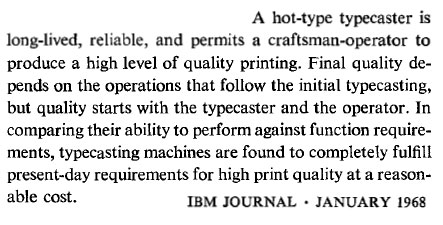Here’s a gem of a paragraph, pulled completely out of context from the 1968 edition of the “IBM Journal”. This issue was composed of articles from the team that developed the IBM Selectric Composer, and the articles explain in painstaking detail the entire design philosophy and describe the minutia of every unique mechanism of the Composer. This paragraph is from the article where the engineers explain the history of typesetting and printing and exactly where the Composer fits in the picture. Contender for the earliest use of the word “Typecasting”? :D
 I may have to change the tagline of my blog to “A Hot-Type Typecaster”, but technically, that would actually apply only to someone who typecasts using an old hot-lead Linotype, prints it on a letterpress, then scans it for their blog. And here, I thought *I* liked doing it the hard way.
I may have to change the tagline of my blog to “A Hot-Type Typecaster”, but technically, that would actually apply only to someone who typecasts using an old hot-lead Linotype, prints it on a letterpress, then scans it for their blog. And here, I thought *I* liked doing it the hard way.
Oh, and I should note that the IBM Journal was typeset with a Selectric Composer, and I find it amusing that if you examine the baseline of the letterforms, the brand-new Composer used to typeset the Journal has a notable amount of wonk in places, similar to my 40+ year old Composer. I’m kind of wondering if they all printed with a tiny amount of wonk in the baseline.. :D
After seeing the output from a brand-new Composer, I will never again give my 90+ year old Oliver and LC Smith judgy side eye for the wonk in their baseline.
the quirky imperfections of purely mechanical processes are, well, inevitable I think – and should be celebrated. Despite its complexity, the Composer is exactly that, A purely mechanical typewriter with electrically powered assist (just a motor and belt that drives a shaft, like any other electric typewriter), not an electronic component to be found anywhere.
The amazing things I’m learning from this Journal issue include the fact that the engineers on this project took the basic Selectric and figured out really amazingly clever solutions to 5 or 6 major engineering problems that had *never* been solved in the way they did, and made it work within an already complex design. It might interest you to know that the machine is capable of 6 to 20 character backspacing memory using a completely mechanical memory register that tracks exactly how many spacing units were used in the previous typing.
I’m pretty sure there is not a single other purely mechanical typewriter that has a built in 19th-century mechanical “difference engine” with 20k of memory and is capable of switching it’s escapement to 27 different possible combinations of spacing ON THE FLY FOR EVERY CHARACTER, and then remembering those positions for backspacing purposes. Even if you discount its extreme rarity, the mechanics of the thing should boot the Composer to the top of any collector’s want list, IMHO :D
A Monotype would also qualify for hot metal typecasting. I loved the Linotype film, but after seeing the Monotype in the extras bit that’s the one I want.